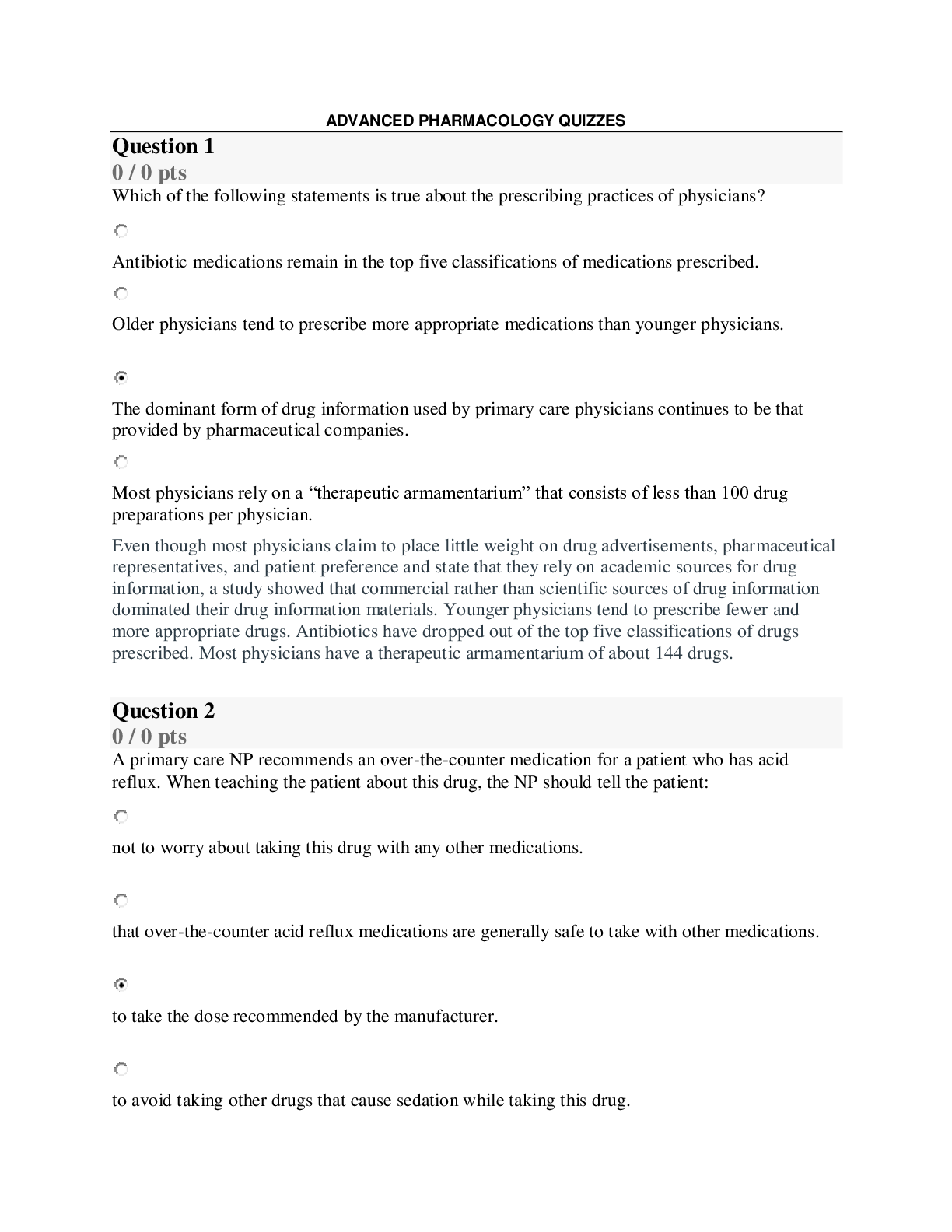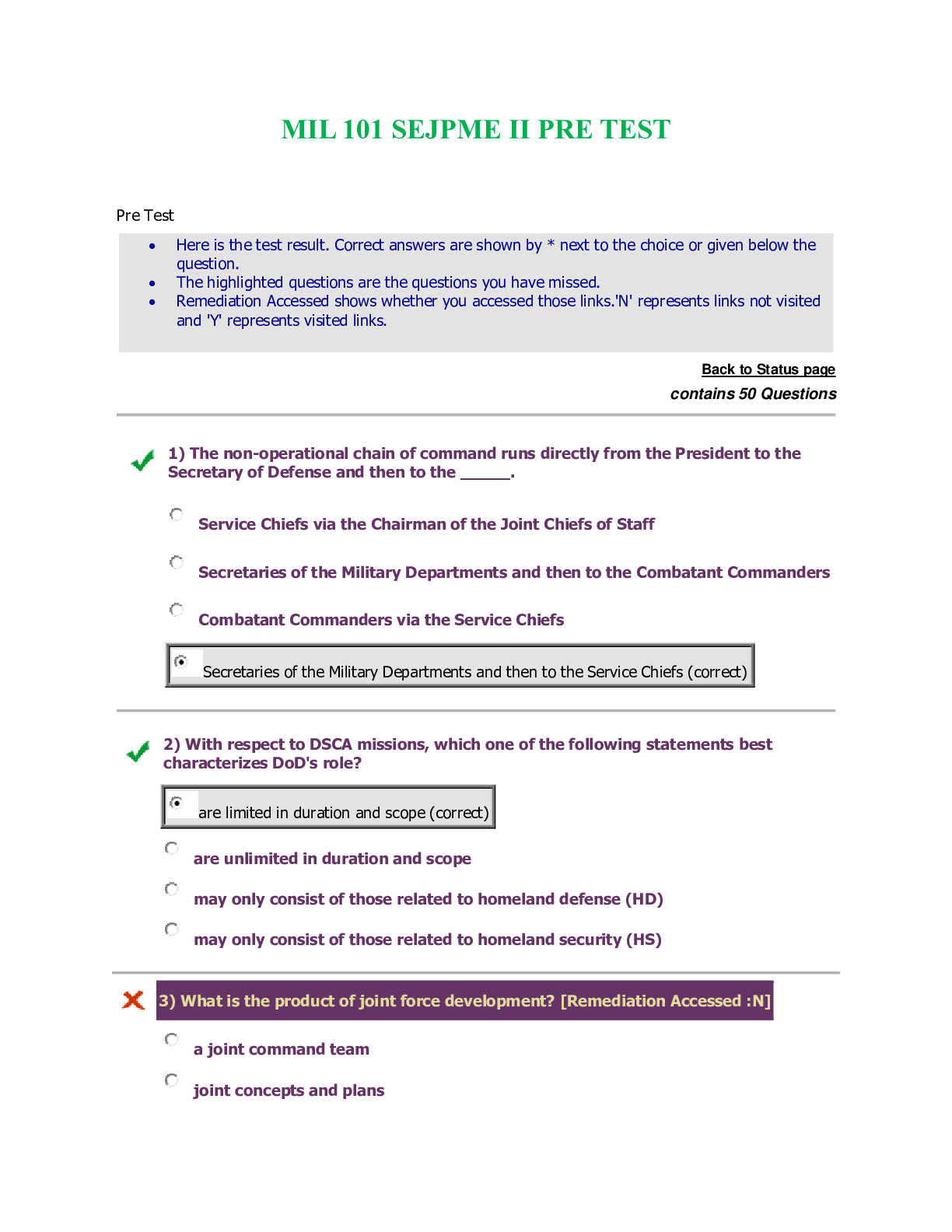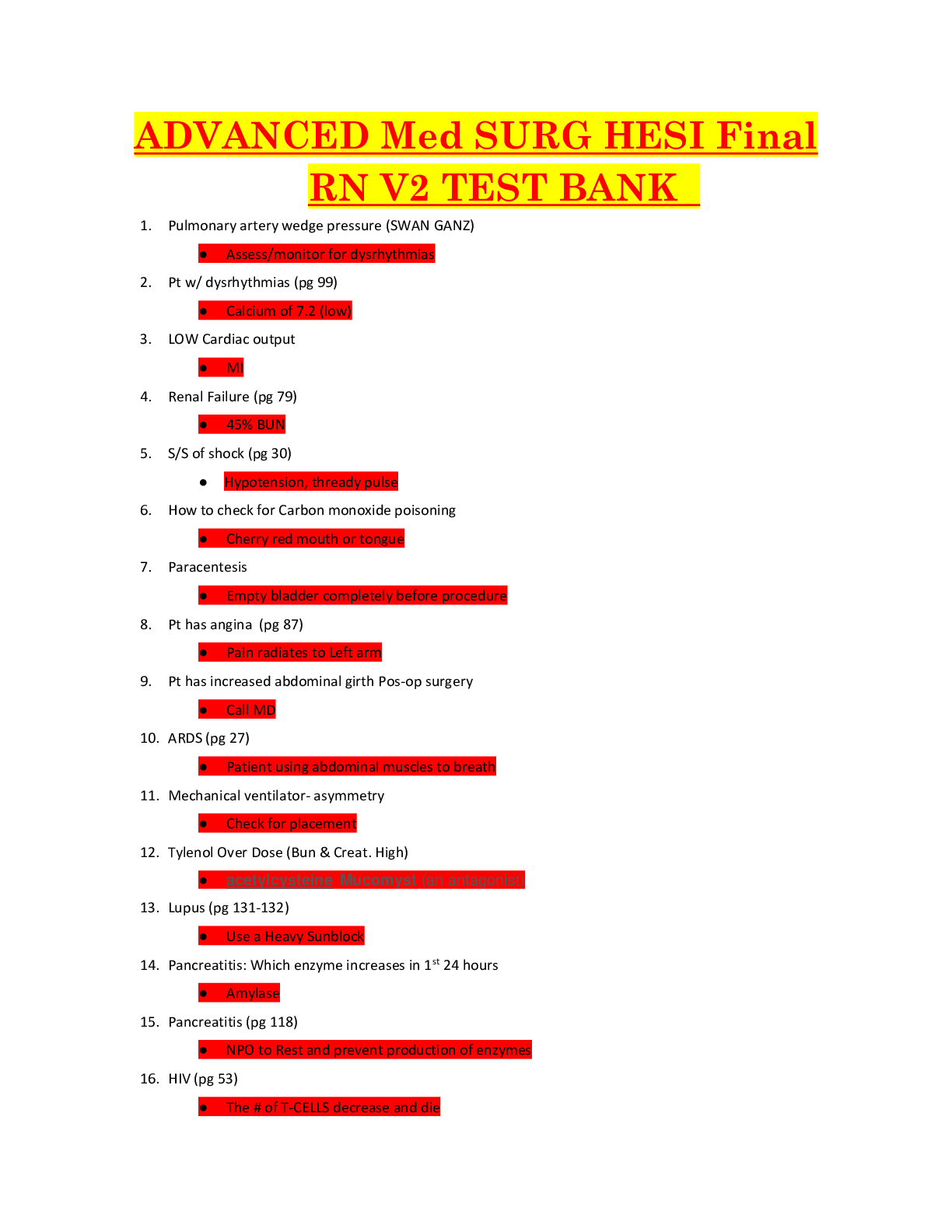Sociology > EXAM > SOCIO 1100 Ch 20 study guide Chowdhury Sociology in our Times (100% CORRECT ANSWERS) (All)
SOCIO 1100 Ch 20 study guide Chowdhury Sociology in our Times (100% CORRECT ANSWERS)
Document Content and Description Below
SOCIO 1100 Ch 20 study guide Chowdhury Sociology in our Times MULTIPLE CHOICE SECTION 1. Sociologists define as the alteration, modification, or transformation of public policy, culture, or soci... al institutions over time. a. social divergence b. social change c. social innovation d. culture wars Answer: b Page: 484 LO: 1 TYPE: Conceptual SOURCE: Modified 2. is voluntary, often spontaneous activity that is engaged in by a large number of people and typically violates dominant group norms and values. a. Social change b. Organizational behavior c. Institutional behavior d. Collective behavior Answer: d Page: 484 LO: 1 TYPE: Conceptual SOURCE: Pickup 3. Collective behavior tends to be . a. institutionalized b. structured hierarchically c. enacted within a division of labor d. unstructured and even spontaneous Answer: d Page: 484 LO: 1 TYPE: Conceptual SOURCE: New 4. Collective behavior occurs as a result of some common influence or stimulus that produces a response from a/an . a. administrative organization b. human service institution c. bureaucracy d. collectivity Answer: d Page: 485 LO: 1 TYPE: Conceptual SOURCE: Modified 5. Which of these is not one of the three major factors that contribute to the likelihood that collective behavior will occur? a. Structural factors that increase the chances of a particular response. b. Timing. c. Environmental factors that create a comfortable or uncomfortable atmosphere. d. A breakdown in social control mechanisms and a corresponding feeling of normlessness. Answer: c Page: 485 LO: 1 TYPE: Conceptual SOURCE: Modified 6. Many credit Rachel Carson’s book as a stimulus for collective behavior geared toward environmental concerns. a. Into the Forest b. Silent Spring c. Walden Pond d. The Lorax Answer: b Page: 485 LO: 1 TYPE: Applied SOURCE: Modified 7. Which of these is not a factor that increases the likelihood that collective behavior will occur? a. quick and easy communication among people b. a breakdown of social control mechanisms c. one general location for gathering d. having the courage to act alone Answer: d Page: 487 LO: 1 TYPE: Conceptual SOURCE: New 8. A(n) is a relatively large number of people who are in one another's immediate vicinity. a. mass b. aggregate c. category d. crowd Answer: d Page: 487 LO: 1 TYPE: Conceptual SOURCE: Pickup 9. People in line to buy tickets for a concert and the audience in a movie theater are both examples of a . a. category b. mass c. crowd d. aggregate Answer: c Page: 487 LO: 1 TYPE: Applied SOURCE: Modified 10. A(n) is a number of people who share an interest in a specific idea or issue but who are not in one another's immediate vicinity. a. mass b. category c. crowd d. aggregate Answer: a Page: 487 LO: 1 TYPE: Conceptual SOURCE: Modified 11. Facebook friends and people following someone on Twitter are examples of technology used to create a(n) . a. category b. crowd c. aggregate d. mass Answer: d Page: 487 LO: 1 TYPE: Applied SOURCE: Modified 12. Sociologist John Lofland states that different forms of collective behavior can be distinguished by the feelings that are expressed and perceived. He terms these the . a. aggregate opinion b. mass point of view c. dominant emotion d. prominent feeling Answer: c Page: 488 LO: 1 TYPE: Conceptual SOURCE: Modified 13. Which of these is not one of the categories developed by Herbert Blumer in order to distinguish different types of crowds? a. casual b. expressive c. passive d. conventional Answer: c Page: 488 LO: 2 TYPE: Conceptual SOURCE: Modified 14. crowds are relatively large gatherings of people who happen to be in the same place at the same time; if they interact at all, it is only briefly. a. Conventional b. Casual c. Acting d. Expressive Answer: b Page: 488 LO: 2 TYPE: Conceptual SOURCE: Pickup 15. People in a shopping mall or on a city bus are examples of crowds. a. casual b. expressive c. acting d. conventional Answer: a Page: 488 LO: 2 TYPE: Applied SOURCE: Pickup 16. crowds are made up of people who come together for a scheduled event and thus share a common focus. a. Acting b. Expressive c. Conventional d. Casual Answer: c Page: 489 LO: 2 TYPE: Conceptual SOURCE: Pickup 17. Students gathered at a college lecture are an example of a(n) crowd. The event has a preestablished schedule and norms so that interaction is likely. The crowd is essential to the event. a. casual b. expressive c. acting d. conventional Answer: d Page: 489 LO: 2 TYPE: Applied SOURCE: Modified 18. crowds provide opportunities for the display of some strong emotion (such as joy, excitement, or grief). People release their pent-up emotions in conjunction with other persons experiencing similar emotions. a. Protest b. Expressive c. Acting d. Conventional Answer: b Page: 489 LO: 2 TYPE: Conceptual SOURCE: Pickup 19. Worshipers at religious revival services and revelers assembled on New Year's Eve at Times Square in New York are examples of crowd. a. a conventional b. an acting c. an expressive d. a casual Answer: c Page: 489 LO: 2 TYPE: Applied SOURCE: Modified 20. crowds are collectivities so intensely focused on a specific purpose or object that they may erupt into violent or destructive behavior. a. Protest b. Expressive c. Acting d. Conventional Answer: c Page: 489 LO: 2 TYPE: Conceptual SOURCE: Pickup 21. Mobs, riots, and panics are all examples of crowds. a. acting b. casual c. expressive d. conventional Answer: a Page: 489 LO: 2 TYPE: Applied SOURCE: Pickup 22. A(n) is a highly emotional crowd whose members engage in, or are ready to engage in, violence against a specific target (such as a person, a category of people, or physical property.) a. riot b. collectivity c. mob d. aggregate Answer: c Page: 489 LO: 2 TYPE: Conceptual SOURCE: Pickup 23. All of these are characteristic of a mob, except . a. it is an acting crowd b. members direct violent action toward a specific target c. tend to be somewhat long in duration d. is highly emotional Answer: c Page: 489 LO: 2 TYPE: Conceptual SOURCE: New 24. Love Canal residents were engaging in behavior when they called attention to their problems with the chemical dump site by staging a protest in which they “burned in effigy” the governor and the health commissioner to emphasize their displeasure with the lack of response from these public officials. a. aggregate b. mob c. riot d. nuclear Answer: b Page: 489 LO: 2 TYPE: Applied SOURCE: Pickup 25. A(n) is violent crowd behavior that is fueled by deep-seated emotions but not directed at one specific target. a. mob b. collectivity c. riot d. aggregate Answer: c Page: 489 LO: 2 TYPE: Conceptual SOURCE: Pickup 26. The looting and other behavior that took place in Los Angeles after the Rodney King trial, and celebrations that turn violent after some sporting events are both examples of . a. aggregates b. mobs c. collectivities d. riots Answer: d Page: 489 LO: 2 TYPE: Conceptual SOURCE: Modified 27. A(n) is a form of crowd behavior that occurs when a large number of people react to a real or perceived threat with strong emotions and self-destructive behavior. a. panic b. riot c. mob d. aggregate Answer: a Page: 489 LO: 2 TYPE: Conceptual SOURCE: Pickup 28. When a gunman recently shot into a crowded movie theater in Colorado, what occurred in the theater would be termed a(n) . a. mob b. aggregate c. panic d. riot Answer: c Page: 489 LO: 2 TYPE: Applied SOURCE: New 29. can arise in response to events that people believe are beyond their control, such as a major disruption in the economy. Although they are relatively rare, they receive massive media coverage because they evoke strong feelings of fear in readers and viewers. a. Mobs b. Panics c. Aggregates d. Riots Answer: b Page: 489 LO: 2 TYPE: Conceptual SOURCE: Pickup 30. Sociologists McPhail and Wohlstein added crowds to the four types of crowds identified by Blumer. These types of crowds engage in activities intended to achieve specific political goals. a. militant b. protest c. rebel d. revolutionary Answer: b Page: 490 LO: 2 TYPE: Conceptual SOURCE: Pickup 31. Sit-ins, marches, boycotts, blockades, and strikes are all examples of crowds. a. Civil Rights b. revolutionary c. militant d. protest Answer: d Page: 490 LO: 2 TYPE: Conceptual SOURCE: Modified 32. The term refers to nonviolent action that seeks to change a policy or law by refusing to comply with it. a. civil insubordination b. civil rebellion c. civil disobedience d. civil dismissiveness Answer: c Page: 490 LO: 2 TYPE: Conceptual SOURCE: Modified 33. Sometimes acts of civil disobedience become violent, as in a confrontation between protesters and police officers. In this case, a protest crowd becomes a/an crowd. a. conventional b. acting c. casual d. expressive Answer: b Page: 490 LO: 2 TYPE: Applied SOURCE: Modified 34. In the 1960s, African American students and sympathetic whites used sit-ins to call attention to racial injustice and demanded social change. When these protests escalated into violent confrontations, these groups became crowds. a. conventional b. casual c. acting d. expressive Answer: c Page: 490 LO: 2 TYPE: Applied SOURCE: Pickup 35. was a French scholar and one of the first social scientists to theorize about explanations for crowd behavior. a. Clark McPhail b. Gustave Le Bon c. Robert Park d. Herbert Blumer Answer: b Page: 490 LO: 3 TYPE: Factual SOURCE: Modified 36. focuses on the social-psychological aspects of collective behavior; it attempts to explain how moods, attitudes, and behavior are communicated rapidly and why they are accepted by others. a. Psychoanalysis b. Convergence theory c. Emergent norm theory d. Contagion theory Answer: d Page: 490 LO: 3 TYPE: Conceptual SOURCE: Pickup 37. argued that people are more likely to engage in antisocial behaviors in a crowd because they are anonymous and feel invulnerable. a. Le Bon b. Hadley Cantrel c. Georg Simmel d. Talcott Parsons Answer: a Page: 490 LO: 3 TYPE: Factual SOURCE: Pickup 38. Which of these statements about contagion theory is true? a. People are less likely to engage in antisocial behavior in a crowd because they feel they are being observed. b. A crowd takes on a life of its own that is larger than the beliefs or actions of any one person. c. Crowds encourage individuals to take responsibility for themselves and others. d. Crowds are easily dispersed once the initial contagion passes. Answer: b Page: 490 LO: 3 TYPE: Conceptual SOURCE: Modified 39. The first U.S. sociologist to investigate crowd behavior was . a. Louis Wirth b. Jane Addams c. Robert Park d. Herbert Gans Answer: c Page: 490 LO: 3 TYPE: Factual SOURCE: New 40. According to sociologist Robert Park, social unrest is transmitted by a process of , in which one person’s discontent is communicated to another, who, in turn, reflects the discontent back to the first person. a. convergence b. mob psychology c. circular reaction d. emergent norms Answer: c Page: 490 LO: 3 TYPE: Conceptual SOURCE: Modified 41. From the perspective of individuals with similar characteristics or attitudes seek others who are similar with whom they can express their predispositions to behave and feel in different ways. a. Circular reaction b. Mob psychology c. Emergent norm theory d. Convergence theory Answer: d Page: 491 LO: 3 TYPE: Conceptual SOURCE: Modified 42. The perspective of suggests that people with similar attributes find a collectivity of like-minded persons with whom they can express their underlying personal tendencies. a. contagion theory b. convergence theory c. emergent norm theory d. psychoanalytic theory Answer: b Page: 491 LO: 3 TYPE: Conceptual SOURCE: Modified 43. Applying convergence theory in his study of a lynch mob, social psychologist Hadley Cantril found that a. the participants came from widely divergent backgrounds b. participants shared traits that made them susceptible to joining a lynch mob even when they didn’t know the target of the lynching c. the participants came primarily from the middle-, and upper-middle classes d. participants knew, and did not like, the target of the lynching Answer: b Page: 491 LO: 3 TYPE: Applied SOURCE: Modified 44. theory emphasizes the importance of social norms in shaping crowd behavior. a. Convergence b. Contagion c. Emergent norm d. Circular reaction Answer: c Page: 491 LO: 3 TYPE: Conceptual SOURCE: Pickup 45. Convergence theory has been criticized because it does not explain a. what draws people in a crowd together in the first place. b. the role of individuals’ predispositions in the formation and behavior of crowds. c. how irrational crowd behavior can be contagious. d. the differences between those people who take collective action and those who do not. Answer: d Page: 491 LO: 3 TYPE: Conceptual SOURCE: New 46. Emergent norm theory is rooted in the perspective. a. functionalist b. symbolic interactionist c. conflict d. postmodernist Answer: b Page: 491 LO: 3 TYPE: Conceptual SOURCE: Modified 47. Sociologists using the approach are interested in how individuals in a given collectivity learn about what is going on, how to interpret activities, and how to behave. a. emergent norm b. circular reaction c. contagion d. convergence Answer: a Page: 491 LO: 3 TYPE: Conceptual SOURCE: Modified 48. Some emergent norms give people a shared conviction that they may disregard ordinary rules such as waiting in line, taking turns, or treating a speaker courteously. These are termed norms. a. permissive b. restrictive c. proactive d. reactive Answer: a Page: 491 LO: 3 TYPE: Conceptual SOURCE: Modified 49. Not all collective behavior takes place in face-to-face collectivities. behavior is collective behavior that takes place when people who may be geographically separated from one another respond to the same event in much the same way. a. Riot b. Mass c. Mob d. Panic Answer: b Page: 491 LO: 4 TYPE: Conceptual SOURCE: Modified 50. The most frequent types of behavior are rumors, gossip, mass hysteria, public opinion, fashions, and fads. a. riot b. mob c. crowd d. mass Answer: d Page: 492 LO: 4 TYPE: Conceptual SOURCE: Modified 51. refers to unsubstantiated reports on an issue or subject. a. Rumors b. Gossip c. Mass hysteria d. Panic Answer: a Page: 492 LO: 4 TYPE: Conceptual SOURCE: Pickup 52. Which of these statements about rumors is false? a. Rumors may be transmitted in an assembled group or among people who are dispersed geographically. b. Rumors get stronger in the face of opposing information; counter information makes the original rumor gain in popularity. c. Although they initially may contain a kernel of truth, as they spread, rumors may be modified to serve the interests of those repeating them. d. Rumors thrive when tensions are high and little authentic information is available on an issue of great concern. Answer: b Page: 492 LO: 4 TYPE: Conceptual SOURCE: Modified 53. refer(s) to rumors about the personal lives of individuals. a. Mass hysteria b. Fads c. Panic d. Gossip Answer: d Page: 492 LO: 4 TYPE: Conceptual SOURCE: Pickup 54. Tabloid newspapers and magazines such as the “National Enquirer” and “People,” and television entertainment “news” programs that present “inside” information on the lives of celebrities are sources of contemporary . a. panic b. fads c. gossip d. mass hysteria Answer: c Page: 492 LO: 4 TYPE: Conceptual SOURCE: Pickup 55. Sociologists refer to a form of dispersed collective behavior that occurs when a large number of people react with strong emotions and self-destructive behavior to a real or perceived threat as mass hysteria or . a. gossip b. rumor c. a mass mob d. panic Answer: d Page: 493 LO: 4 TYPE: Conceptual SOURCE: Modified 56. In 1938, actor Orson Welles hosted a radio broadcast dramatizing H.G. Wells's science fiction classic “The War of the Worlds.” A CBS radio dance music program was interrupted suddenly by a news bulletin informing the audience that Martians had landed in New Jersey and were in the process of conquering the earth. The ensuing reaction was an example of . a. mass hysteria b. propaganda c. public opinion d. mass mob behavior Answer: a Page: 493 LO: 4 TYPE: Applied SOURCE: Pickup 57. A is a temporary but widely copied activity enthusiastically followed by large numbers of people. a. style b. fad c. craze d. fashion Answer: b Page: 493 LO: 5 TYPE: Conceptual SOURCE: Pickup 58. A is defined as a currently valued manner of behavior, thinking, or appearance that endures for a period of time. a. style b. fad c. fashion d. craze Answer: c Page: 493 LO: 5 TYPE: Conceptual SOURCE: Modified 59. The difference between a fad and a fashion is that a. a fashion is shorter-lived than a fad. b. fashions tend to be more widely embraced than fads. c. fads take the form of behaviors, like diets, but not material objects. d. fashions tend to last longer than fads. Answer: d Page: 493 LO: 5 TYPE: Conceptual SOURCE: New 60. The text observes that most sociological research on fashion has focused on . a. clothing, especially women's apparel b. men's accessories c. the t-shirt craze d. hairstyles Answer: a Page: 493 LO: 5 TYPE: Applied SOURCE: Pickup 61. Sociologist suggested a classic “trickle-down” theory to describe the process by which members of the lower classes emulate the fashions of the upper class. a. Herbert Blumer b. Pierre Bourdieu c. Thorstein Veblen d. Georg Simmel Answer: d Page: 493 LO: 5 TYPE: Factual SOURCE: Pickup 62. Sociologist asserted that fashion serves mainly to institutionalize conspicuous consumption among the wealthy. a. Georg Simmel b. Thorstein Veblen c. Pierre Bourdieu d. Herbert Blumer Answer: b Page: 493 LO: 5 TYPE: Factual SOURCE: Pickup 63. In his theory of fashion, Herbert Blumer has argued that a. fashion serves mainly to institutionalize conspicuous consumption among the wealthy. b. members of the lower classes emulate the fashions of the upper class. c. matters of taste constitute a form of cultural capital. d. taste is a matter of experience and a matter of collective selection. Answer: d Page: 494 LO: 5 TYPE: Conceptual SOURCE: New 64. Propaganda a. is always false. b. is measured through polls and surveys. c. is disseminated by those with a vested interest in the issue. d. is information that comes from governmental agencies. Answer: c Page: 494 LO: 5 TYPE: Conceptual SOURCE: New 65. Members of the public attempt to influence those in power, and vice versa, with the dissemination of ,which is information provided by those with a vested interest in furthering their own cause or damaging an opposing one. a. propaganda b. rumor c. public opinion d. cultural capital Answer: a Page: 494 LO: 5 TYPE: Conceptual SOURCE: Modified 66. is an organized group that acts consciously to promote or resist change through collective action. It tends to be long lasting, is organized, and has specific goals or purposes. a. A revolution b. Civil disobedience c. A social movement d. An acting mob Answer: c Page: 494 LO: 6 TYPE: Conceptual SOURCE: Modified 67. Which of these statements about how social movements differ from other forms of collective behavior is false? a. Social movements are more organized. b. Social movements are shorter-lived. c. Social movements have specific goals. d. Social movements consciously promote or resist change. Answer: b Page: 494 LO: 6 TYPE: Conceptual SOURCE: New 68. The most common target of social movement activity is . a. the government b. corporations c. the public d. other social movement organizations Answer: a Page: 495 LO: 6 TYPE: Applied SOURCE: New 69. Which statement concerning social movements is false? a. Most rely on volunteers. b. Women are strongly represented in membership and leadership. c. They make democracy more available to excluded groups. d. They can be easily categorized according to their ideology. Answer: d Page: 495 LO: 6 TYPE: Conceptual SOURCE: Modified 70. movements seek to improve society by changing some specific aspect of the social structure, such as public policy, to bring it in line with their own values and beliefs. a. Revolutionary b. Reform c. Alternative d. Resistance (regressive) Answer: b Page: 496 LO: 6 TYPE: Conceptual SOURCE: Modified 71. Labor movements, animal rights movements, antinuclear movements, Mothers Against Drunk Drivers (MADD), and the disability rights movement are all examples of . a. revolutionary movements b. alternative movements c. reform movements d. resistance (regressive) movements Answer: c Page: 496 LO: 6 TYPE: Conceptual SOURCE: Modified 72. movements seek to bring about a total change in society. These movements usually do not attempt to work within the existing system; rather, they aim to remake the system by replacing existing institutions with new ones. a. Reform b. Religious (expressive) c. Alternative d. Revolutionary Answer: d Page: 496 LO: 6 TYPE: Conceptual SOURCE: Pickup 73. Radical terrorists who use fear tactics to intimidate those with whom they disagree ideologically are members of movements. a. revolutionary b. religious (expressive) c. alternative d. reform Answer: a Page: 496 LO: 6 TYPE: Applied SOURCE: Modified 74. The Weather Underground was a radical anti-war group during the 1960s that was responsible for many robberies and bombings of buildings. This group would be considered a movement. a. reform b. revolutionary c. religious d. reactionary Answer: b Page: 496 LO: 6 TYPE: Applied SOURCE: Modified 75. Movements that seek to produce radical change in individuals and are based on spiritual or supernatural belief systems are called . a. alternative b. reform c. resistance (regressive) d. religious (expressive) Answer: d Page: 496 LO: 6 TYPE: Conceptual SOURCE: Modified 76. Hare Krishna, Scientology, the Unification Church, and the Divine Light Mission are all examples of movements. a. alternative b. reform c. resistance (regressive) d. religious (expressive) Answer: d Page: 497 LO: 6 TYPE: Applied SOURCE: New 77. movements seek limited change in some aspect of people's behavior. a. Alternative b. Religious (expressive) c. Revolutionary d. Reform Answer: a Page: 497 LO: 6 TYPE: Conceptual SOURCE: Pickup 78. “New Age” movements today and the Women’s Christian Temperance movement of the past are both examples of movements. a. resistance (regressive) b. revolutionary c. alternative d. religious (expressive) Answer: c Page: 497 LO: 6 TYPE: Applied SOURCE: Modified 79. movements seek to prevent change or to undo change that has already occurred. a. Alternative b. Revolutionary c. Reform d. Resistance (regressive) Answer: d Page: 497 LO: 6 TYPE: Conceptual SOURCE: Pickup 80. Efforts to oppose school integration, civil rights and affirmative action legislation, and domestic partnership initiatives are all actions taken by movements. a. alternative b. reform c. resistance (regressive) d. revolutionary Answer: c Page: 497 LO: 6 TYPE: Applied SOURCE: Modified 81. In the stage of a social movement, widespread unrest is present as people become aware of a problem. At this stage, leaders emerge to agitate others into taking action. a. preliminary (incipiency) b. coalescence c. institutionalization (bureaucratization) d. intermediate Answer: a Page: 497 LO: 6 TYPE: Conceptual SOURCE: Pickup 82. In the stage of a social movement, people begin to organize and to publicize the problem. At this stage, some movements become formally organized at local and regional levels. a. intermediate b. institutionalization (bureaucratization) c. preliminary (incipiency) d. coalescence Answer: d Page: 497 LO: 6 TYPE: Conceptual SOURCE: Pickup 83. In the stage of a social movement, an organizational structure develops, and a paid staff (rather than volunteers) begins to lead the group. a. preliminary (incipiency) b. coalescence c. institutionalization (bureaucratization) d. intermediate Answer: c Page: 497 LO: 6 TYPE: Conceptual SOURCE: Pickup 84. According to theory, people who are satisfied with their present condition are less likely to seek social change. Social movements arise as a response to people’s perception that they have been deprived of their “fair share.” a. value-added b. resource mobilization c. social constructionist d. relative deprivation Answer: d Page: 498 LO: 7 TYPE: Conceptual SOURCE: Pickup 85. refers to the discontent that people may feel when they compare their achievements with those of similarly situated persons and find that they have less than they think they deserve. a. Relative deprivation b. Conditional deprivation c. Absolute deprivation d. Structured deprivation Answer: a Page: 498 LO: 7 TYPE: Conceptual SOURCE: Pickup 86. theory is based on the assumption that certain conditions are necessary for the development of a social movement, and that each condition contributes to the those preceding in making a social movement more likely. a. Relative deprivation b. Value-added c. Resource mobilization d. Social constructionist Answer: b Page: 498 LO: 7 TYPE: Conceptual SOURCE: Modified 87. Movements are more likely to occur when a person, class, or agency can be singled out as the source of the problem. This illustrates the condition of within value- added theory. a. structural conduciveness b. structural strain c. precipitating factors d. social control factors Answer: a Page: 498 LO: 7 TYPE: Conceptual SOURCE: Modified 88. When a society or community is unable to meet people’s expectations that something should be done about a problem, tension occurs in the system. This is the condition of within Smelser’s value-added theory. a. spread of a generalized belief b. mobilization for action c. structural strain d. social control Answer: c Page: 498 LO: 7 TYPE: Conceptual SOURCE: Modified 89. For a movement to develop there must be a clear statement of the problem and a shared view of its causes, effects, and possible solutions. This illustrates the value-added condition of . a. precipitating factors b. spread of a generalized belief c. structural conduciveness d. social control factors Answer: b Page: 498 LO: 7 TYPE: Conceptual SOURCE: Modified 90. To reinforce the existing generalized belief, an inciting incident or dramatic event must occur. This is the condition of value-added theory. a. social control factors b. mobilization for action c. precipitating factors d. structural strain Answer: c Page: 498 LO: 7 TYPE: Conceptual SOURCE: Modified 91. As a social movement develops, leaders emerge to organize others and give them a sense of direction. This is the value-added condition of . a. mobilization for action b. social control factors c. spread of a generalized belief d. structural conduciveness Answer: a Page: 498 LO: 7 TYPE: Conceptual SOURCE: Modified 92. theory takes into account the complexity of social movements and makes it possible to test assertions regarding the necessary and sufficient conditions that produce such movements. a. Resource mobilization b. Relative deprivation c. Social Constructionist d. Value-added Answer: d Page: 498 LO: 7 TYPE: Conceptual SOURCE: Pickup 93. theory focuses on the ability of members of a social movement to acquire resources and mobilize people in order to advance their cause. a. Resource mobilization b. Resource-added c. Relative deprivation d. New social movement Answer: a Page: 498 LO: 7 TYPE: Conceptual SOURCE: Pickup 94. theory is based on the assumption that participants in social movements make rational decisions about goals and actions, and must have some degree of economic and political resources to make the movement a success. a. Value-added b. Resource mobilization c. New social movement d. Relative deprivation Answer: b Page: 498 LO: 7 TYPE: Conceptual SOURCE: Modified 95. theory is based on the assumption that a social movement is an interactive, symbolically defined, and negotiated process that involves participants, opponents, and bystanders. a. Relative deprivation b. Value-added c. Resource mobilization d. Social constructionist Answer: d Page: 499 LO: 8 TYPE: Conceptual SOURCE: Pickup 96. reflects the influence of sociologist Erving Goffman’s “Frame Analysis,” in which he suggests that our interpretation of the particulars of events and activities is dependent on the framework from which we perceive them. a. Social constructionist theory b. Value-added theory c. Relative deprivation theory d. Resource mobilization Answer: a Page: 499 LO: 8 TYPE: Conceptual SOURCE: Pickup 97. The social constructionist theorists have identified three ways of framing an issue. A frame presents solutions or remedies based on the target that has been identified. a. diagnostic b. prognostic c. motivational d. behavioral Answer: b Page: 499 LO: 8 TYPE: Conceptual SOURCE: New 98. From the perspective of political opportunity theory, social movements a. are best explained by relative deprivation that motivates individuals to take action. b. are always somewhat resistant because they take place outside of conventional governing systems. c. are interconnected with organizations and circumstances both within and outside of mainstream political systems. d. must present their concerns and proposed solutions in such a way as to appeal to the general public. Answer: c Page: 501 LO: 8 TYPE: Conceptual SOURCE: New 99. Environmental justice and ecofeminism are examples of . a. reform movements b. resistance movements c. new social movements d. millenarian movements Answer: c Page: 502 LO: 8 TYPE: Applied SOURCE: New 100. Which of these is not a social factor that contributes to social change? a. changing social institutions b. new technologies c. population trends d. natural disasters Answer: d Page: 505 LO: 8 TYPE: Applied SOURCE: New TRUE-FALSE SECTION 1. Collective behavior lacks the organizational structure of other forms of behavior. Answer: True Page: 484 LO: 1 TYPE: Conceptual SOURCE: New 2. Collective behavior is very contemporary; it began with the Civil Rights Movement in the 1950s. Answer: False Page: 485 LO: 1 TYPE: Applied SOURCE: New Rejoinder: Collective behavior dates back to the transition from feudalism, if not earlier. Early sociologists were responding to collective behavior more than 100 years ago. 3. A common stimulus is an important factor in collective behavior. Answer: True Page: 485 LO: 1 TYPE: Conceptual SOURCE: New 4. Collective behavior can best be understood using theories that apply to individual behavior, since a collectivity is essentially the sum of the actions of many different individuals. Answer: False Page: 487 LO: 1 TYPE: Conceptual SOURCE: New Rejoinder: Collective behavior has its own nature beyond the actions of individuals. It is a joint response to a common stimulus. 5. Mob violence tends to dissipate relatively quickly once a target has been injured, killed, or destroyed. 6. Answer: True Crowd behavior Page: 489 is irrational. LO: 2 TYPE: Conceptual SOURCE: Modified Answer: False Page: 491 LO: 3 TYPE: Conceptual SOURCE: New Rejoinder: Although people may express themselves freely in crowds, their behavior is not irrational and is generally easy to understand by those who share similar emotions and beliefs. 7. Social movements sometimes fit the definition of mass behavior. Answer: True Page: 491 LO: 4 TYPE: Conceptual SOURCE: New 8. When officials counter a rumor with authentic information this only serves to strengthen belief in the original rumor. Answer: False Page: 492 LO: 4 TYPE: Conceptual SOURCE: New Rejoinder: Actually, people give rumors more credence when there is no opposing information available. 9. Once a rumor begins to circulate, it seldom stops unless compelling information comes out that disproves the rumor or makes it obsolete. Answer: True Page: 492 LO: 4 TYPE: Conceptual SOURCE: New 10. By definition, fads last longer than fashions. Answer: False Page: 493 LO: 5 TYPE: Conceptual SOURCE: Modified Rejoinder: Just the opposite is true. A fad is defined as temporary but widely copied, while fashions tend to be longer lasting. 11. Contrary to the beliefs of Bourdieu and Simmel, in contemporary society fashion often “trickles up.” Answer: True Page: 494 LO: 5 TYPE: Conceptual SOURCE: New 12. Propaganda refers to generally false information that disseminated by those in power in efforts to fool the public into accepting their perspective. Answer: False Page: 494 LO: 5 TYPE: Conceptual SOURCE: New Rejoinder: Propaganda is not always false and may be used by groups and individuals, regardless of status, to persuade others. 13. Social movements are more likely to develop in industrial societies than in preindustrialized societies. Answer: True Page: 495 LO: 6 TYPE: Conceptual SOURCE: New 14. All expressive social movements are religious in nature. Answer: False Page: 496 LO: 6 TYPE: Conceptual SOURCE: New Rejoinder: Expressive movements promote inner or spiritual change, so that the practice of Eastern philosophies or yoga might fit this definition although they are not explicitly religious. 15. Virtually all contemporary reform social movements face resistance from one or more reactive or regressive movements. Answer: True Page: 497 LO: 6 TYPE: Conceptual SOURCE: New 16. When social movements become institutionalized the initial zeal and idealism of members may diminish and early grassroots supporters may become disillusioned and drop out. Answer: True Page: 497 LO: 6 TYPE: Conceptual SOURCE: Modified 17. All people who experience discontent or relative deprivation will eventually join a social movement of some type. Answer: False Page: 498 LO: 7 TYPE: Conceptual SOURCE: New Rejoinder: This is one of the problems with relative deprivation theory. Feelings of deprivation may be necessary for the creation of a social movement, but they are not a sufficient explanation. Many people who feel deprived do not take any action. 18. Widespread discontent alone does not produce a social movement. Answer: True Page: 499 LO: 7 TYPE: Conceptual SOURCE: New 19. In cities that provide opportunities for protests to be heard within local government, there is less social unrest and fewer public disruptions. Answer: True Page: 501 LO: 8 TYPE: Applied SOURCE: New 20. The loss of property and life that resulted from Hurricane Katrina can properly be termed a natural disaster. Answer: False Page: 505 LO: 8 TYPE: Applied SOURCE: New Rejoinder: While the wave that hit the Gulf Coast can be called a natural disaster, what followed were the consequences of human action. Decisions about funding priorities and the infrastructure were fundamental to the amount of damage and loss that was suffered. [Show More]
Last updated: 2 years ago
Preview 1 out of 22 pages

Buy this document to get the full access instantly
Instant Download Access after purchase
Buy NowInstant download
We Accept:

Reviews( 0 )
$14.50
Can't find what you want? Try our AI powered Search
Document information
Connected school, study & course
About the document
Uploaded On
Oct 20, 2022
Number of pages
22
Written in
Additional information
This document has been written for:
Uploaded
Oct 20, 2022
Downloads
0
Views
41



 Questions and Answers 100% VERIFIED.png)
 Questions and Answers 100% correct Solutions.png)






.png)

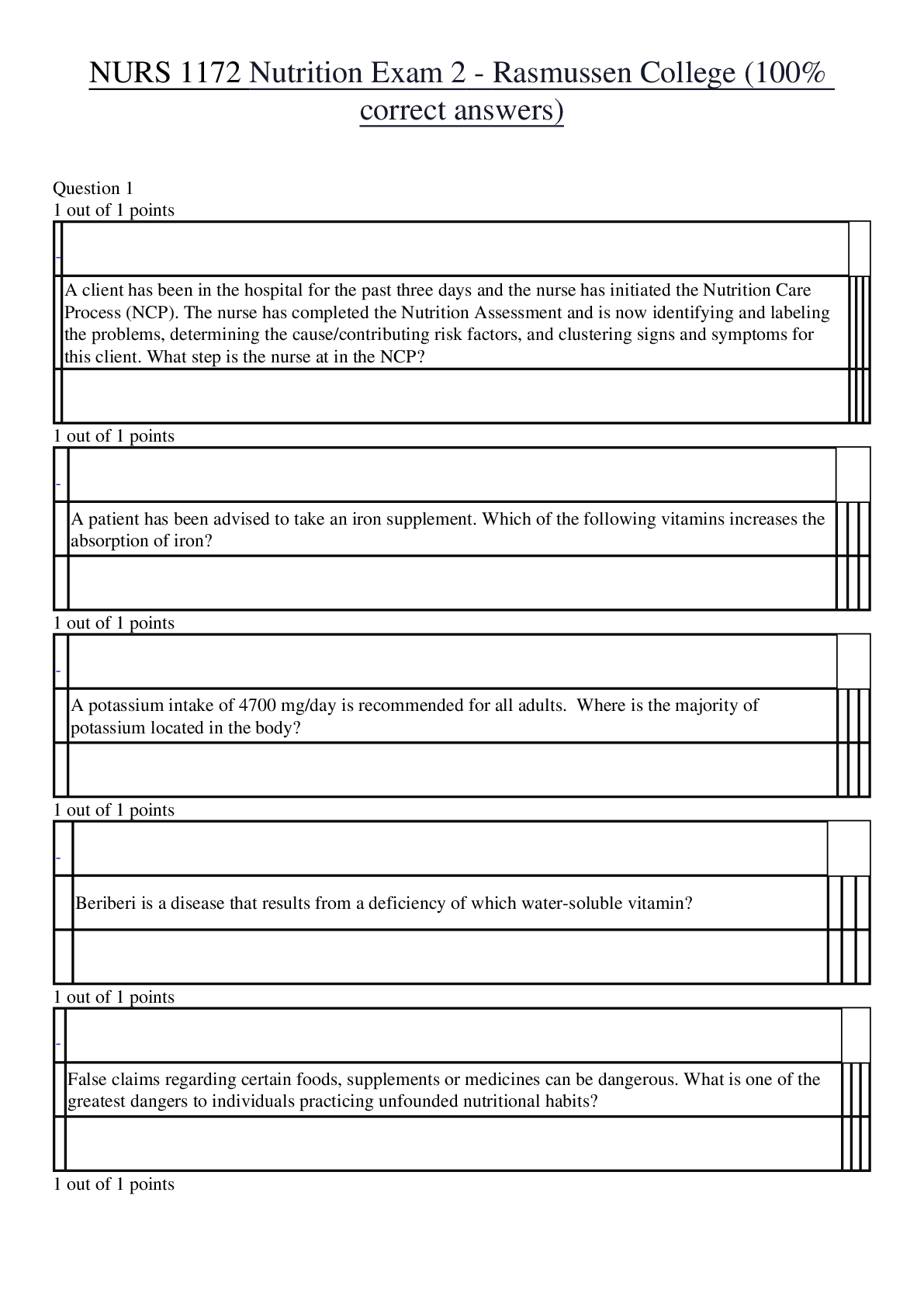
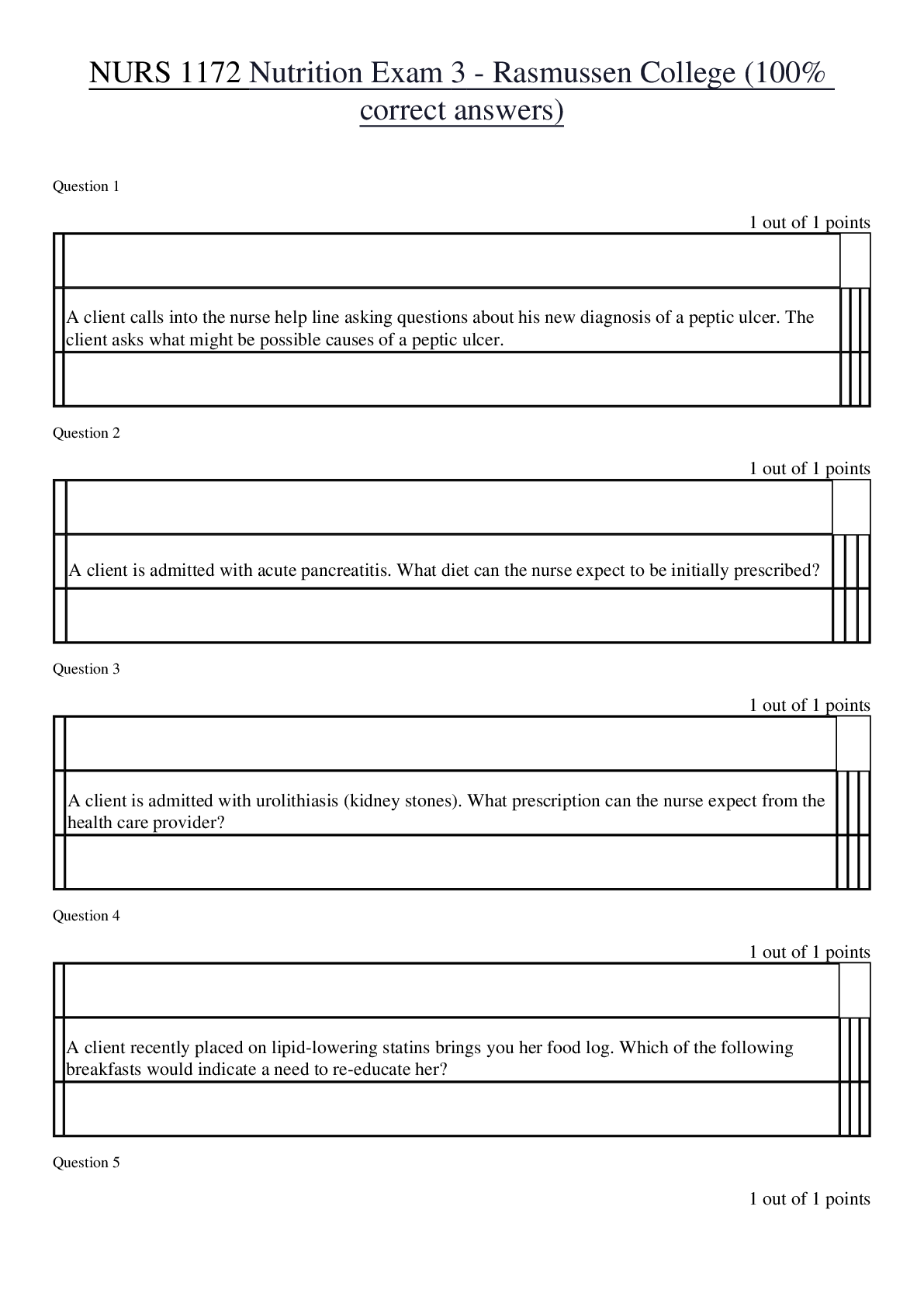
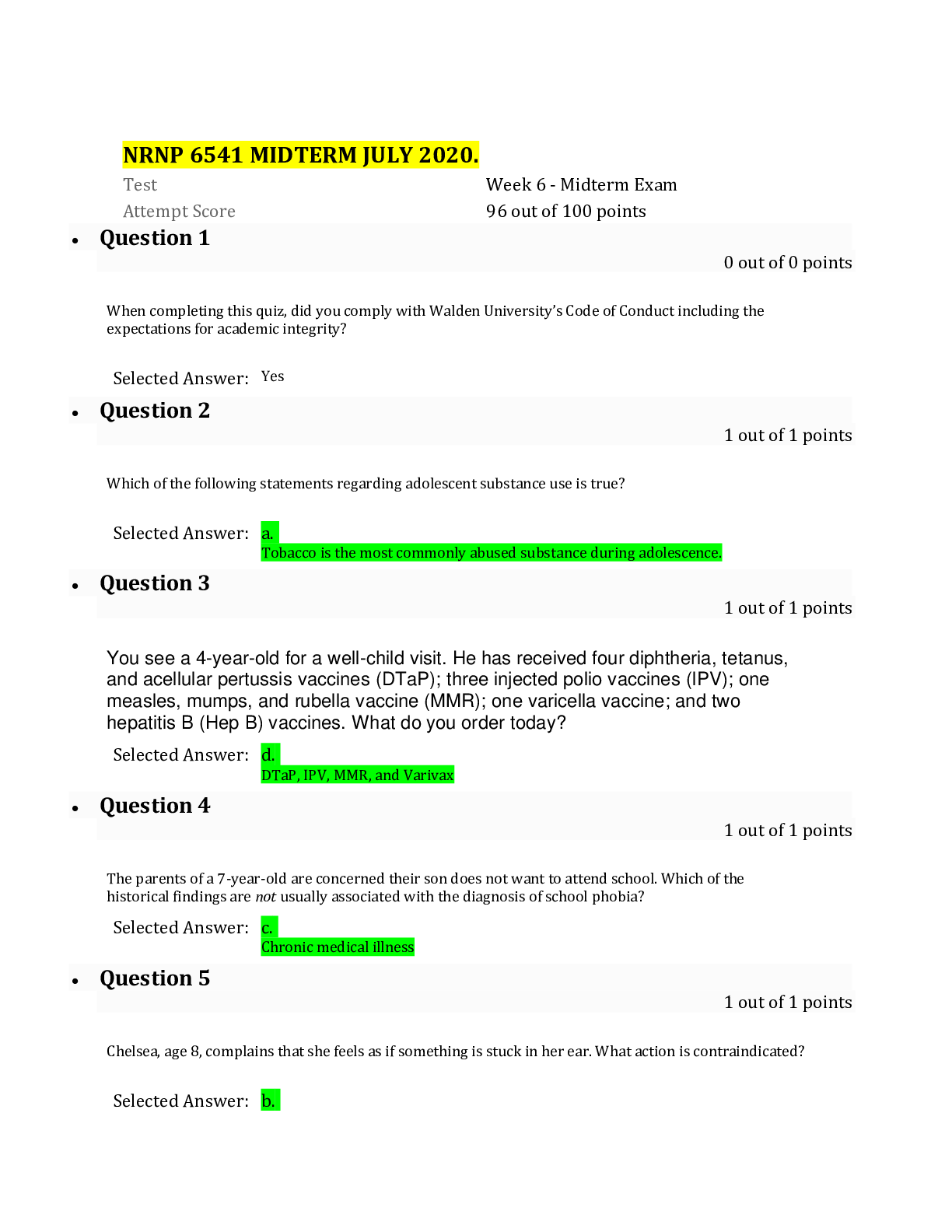
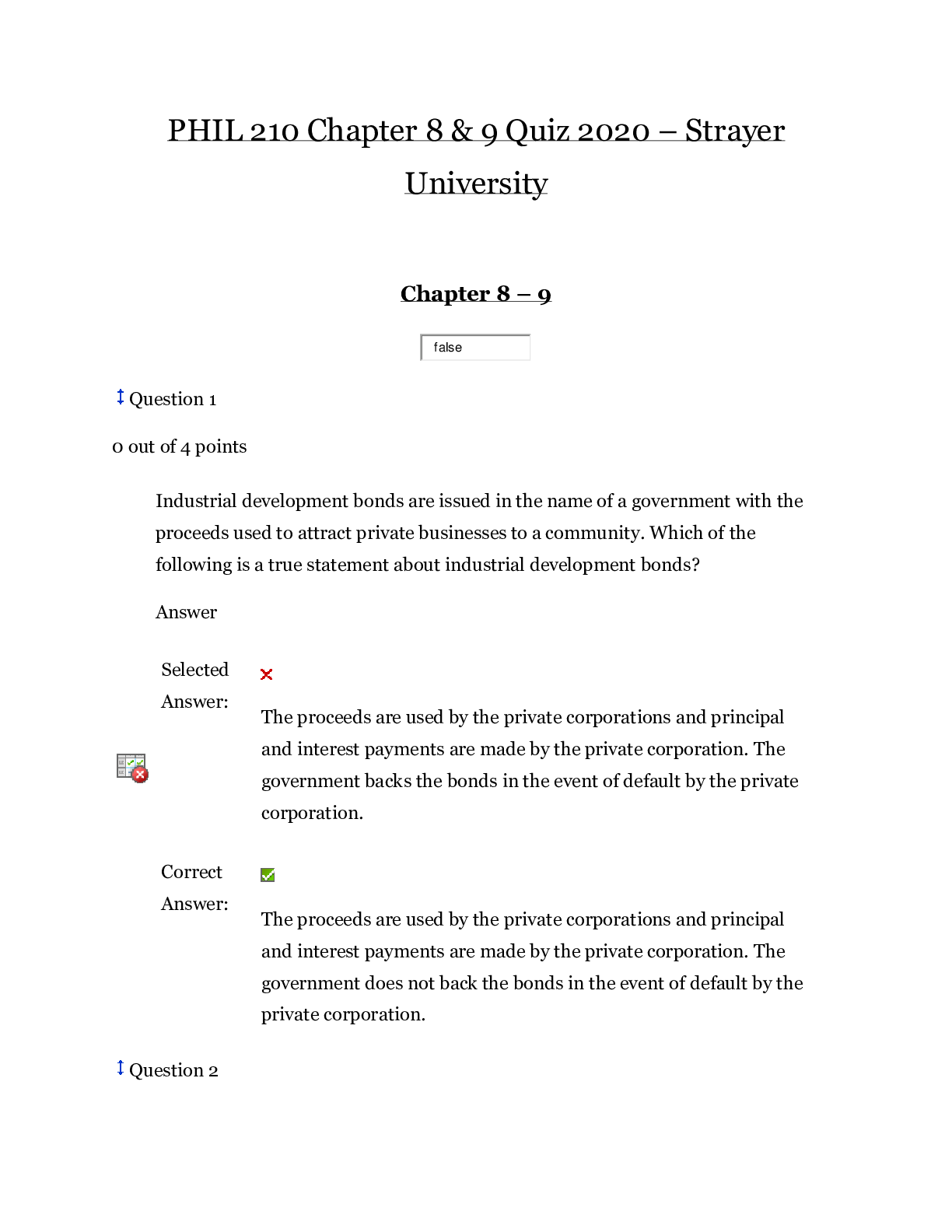
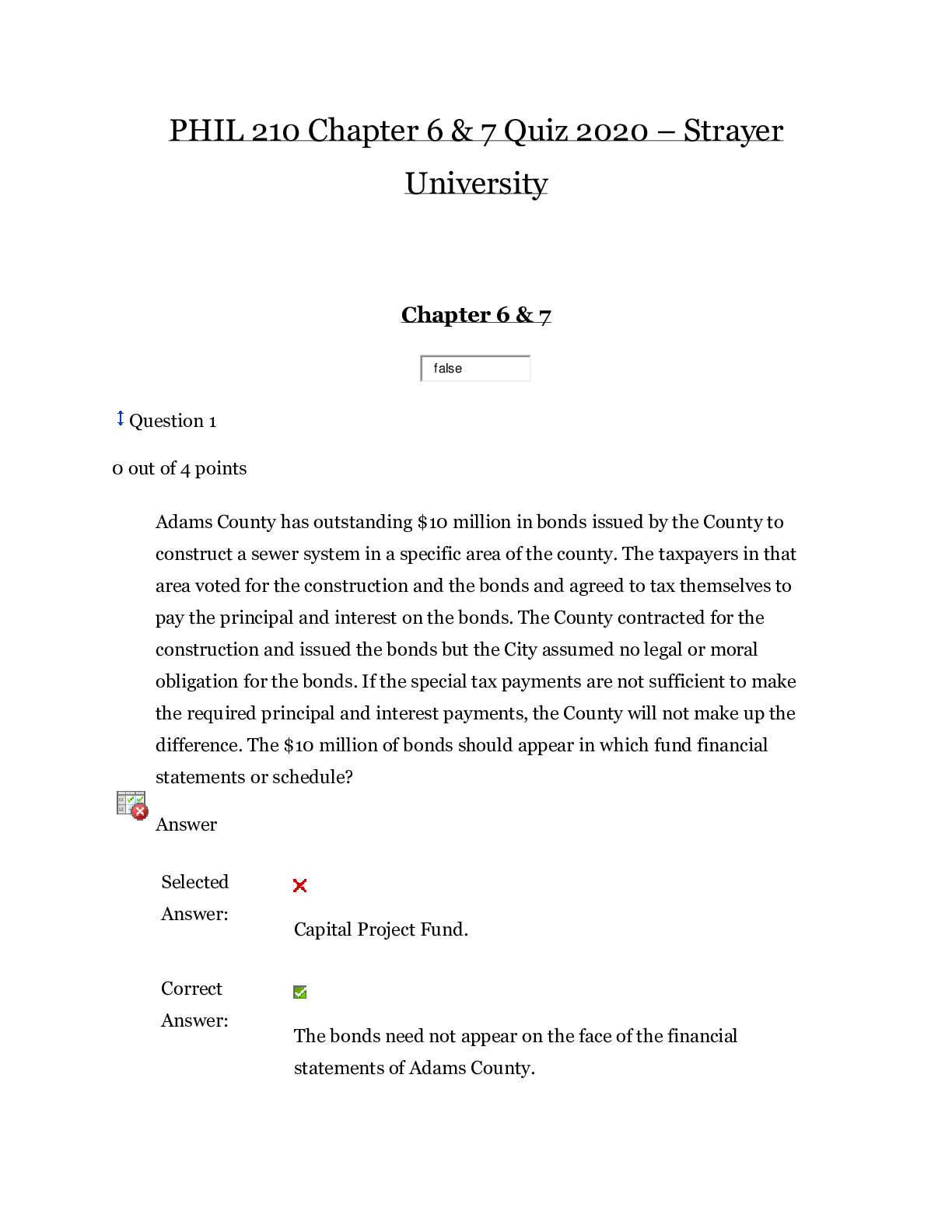
 – Strayer University.png)



